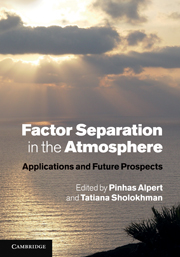Book contents
- Frontmatter
- Contents
- List of contributors
- Foreword
- Preface
- 1 Introduction
- 2 The Factor Separation Methodology and the fractional approach
- 3 Investigation of the Factor Separation features for basic mathematical functions
- 4 Factor Separation Methodology and paleoclimates
- 5 Meso-meteorology: Factor Separation examples in atmospheric meso-scale motions
- 6 Using the Alpert–Stein Factor Separation Methodology for land-use land-cover change impacts on weather and climate process with the Regional Atmospheric Modeling System
- 7 Application of Factor Separation to heavy rainfall and cyclogenesis: Mediterranean examples
- 8 Experience in applying the Alpert–Stein Factor Separation Methodology to assessing urban land-use and aerosol impacts on precipitation
- 9 Free and forced thermocline oscillations in Lake Tanganyika
- 10 Application of the Factor Separation Methodology to quantify the effect of waste heat, vapor and pollution on cumulus convection
- 11 The use of the Alpert–Stein Factor Separation Methodology for climate variable interaction studies in hydrological land surface models and crop yield models
- 12 Linear model for the sea breeze
- 13 Experience and conclusions from the Alpert–Stein Factor Separation Methodology
- 14 Tagging systematic errors arising from different components of dynamics and physics in forecast models
- 15 Some difficulties and prospects
- 16 Summary
- Appendix: References employing the Alpert–Stein Factor Separation Methodology
- References
- Index
Preface
Published online by Cambridge University Press: 03 May 2011
- Frontmatter
- Contents
- List of contributors
- Foreword
- Preface
- 1 Introduction
- 2 The Factor Separation Methodology and the fractional approach
- 3 Investigation of the Factor Separation features for basic mathematical functions
- 4 Factor Separation Methodology and paleoclimates
- 5 Meso-meteorology: Factor Separation examples in atmospheric meso-scale motions
- 6 Using the Alpert–Stein Factor Separation Methodology for land-use land-cover change impacts on weather and climate process with the Regional Atmospheric Modeling System
- 7 Application of Factor Separation to heavy rainfall and cyclogenesis: Mediterranean examples
- 8 Experience in applying the Alpert–Stein Factor Separation Methodology to assessing urban land-use and aerosol impacts on precipitation
- 9 Free and forced thermocline oscillations in Lake Tanganyika
- 10 Application of the Factor Separation Methodology to quantify the effect of waste heat, vapor and pollution on cumulus convection
- 11 The use of the Alpert–Stein Factor Separation Methodology for climate variable interaction studies in hydrological land surface models and crop yield models
- 12 Linear model for the sea breeze
- 13 Experience and conclusions from the Alpert–Stein Factor Separation Methodology
- 14 Tagging systematic errors arising from different components of dynamics and physics in forecast models
- 15 Some difficulties and prospects
- 16 Summary
- Appendix: References employing the Alpert–Stein Factor Separation Methodology
- References
- Index
Summary
This book is the result of almost two decades of research initiated in 1991 by an idea that sensitivity studies in the atmosphere were not being performed in the proper manner.My Ph.D. student Uri Stein was simulating the effects of two central factors on the rainfall over the Eastern Mediterranean with the Mesoscale Model MM4: Mediterranean Sea fluxes and topography. I called Uri, on a Friday in 1991, suggesting that the three simulations he was performing were not enough to capture the potential synergy or interaction between these two factors and that an additional simulation should be performed. Consequently,we developed the Factor Separation Methodology that allows for the separation of four potential contributions in our two-factor problem and 2n simulations for any n-factor problem. This separation included specifically the double synergy term which is the net result of interaction between the two factors. As I had expected, we found immediately that the synergy term plays a central role in the atmosphere, one that is often larger than the net contribution of any singular factor's contribution.
When our paper was submitted in 1992 to the Journal of Atmospheric Sciences, I did not know what to expect. It seemed to me that the method was so basic that I could not believe we were the first to apply it in atmospheric sciences. However, our extensive literature search did not show any similar publications.
- Type
- Chapter
- Information
- Factor Separation in the AtmosphereApplications and Future Prospects, pp. xv - xviiiPublisher: Cambridge University PressPrint publication year: 2011



